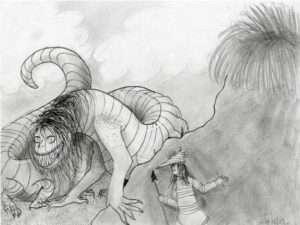
Worm, Insect — Kinguk
Tawa kingugturningaitua! – No, I won’t eat worms!
Earthworms are relatively rare in Alaska. Despite the abundance and notoriety of their cousin the ice worm, earthworms do not thrive in acidic forest soils or in areas with extensively frozen ground. Of the 1,800 known species of earthworms, the only naturally occurring Alaska species is Bismastos tenuis, one of the world’s smaller earthworms.
If Kodiak was largely ice-covered during the last glacial epoch, how did worms get to the archipelago? It is likely they were unintentionally introduced in postglacial times by people and animals. Earthworms lay their eggs in small cocoon-like capsules. Scientists speculate that worm eggs were transported to places like Kodiak in dirt clinging to feathers, fur, or feet. Redeposited in good soil, the eggs hatched, and the resulting worms thrived. Today, Kodiak has a variety of earthworms, some of which have been intentionally imported by gardeners.
Although earthworms may have been less common in the past, they were known. An Alutiiq story from Afognak Island tells of a giant, rainbow-colored man-worm. This ravenous creature had the face of a man, the body of a worm, many human feet, and toward its tail, an eagle’s talons. The worm ate continuously, devouring everything it encountered. Only a whaler, one of Kodiak’s most spiritually powerful hunters, was able to kill the beast. Similar man-worm stories are found among the Yup’ik people.
Listen to podcast at Alutiiq Museum
